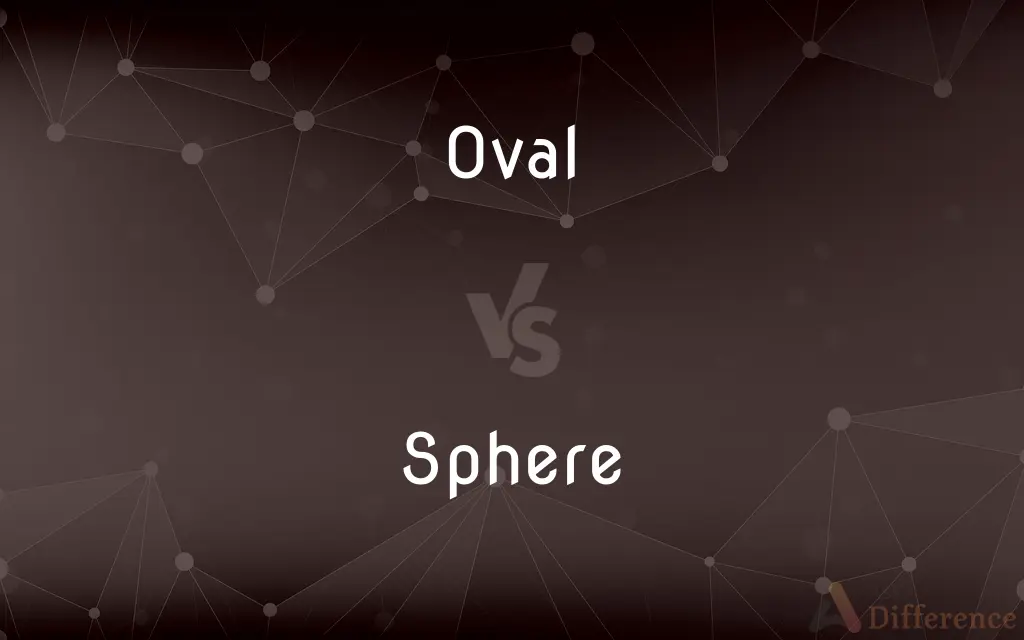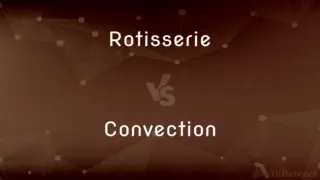Oval vs. Sphere — What's the Difference?
By Tayyaba Rehman & Maham Liaqat — Updated on February 28, 2024
An oval is a flat, elongated, curved shape resembling an egg, mainly defined in two dimensions, while a sphere is a three-dimensional object where all surface points are equidistant from the center, like a ball.

Difference Between Oval and Sphere
Table of Contents
ADVERTISEMENT
Key Differences
The fundamental difference between an oval and a sphere lies in their dimensionality. An oval is a two-dimensional shape, existing on a flat plane and defined by its length and width. A sphere, conversely, is a three-dimensional object with length, width, and depth, defined by every point on its surface being equidistant from its center.
An oval appears as a flattened circle with a broader middle and tapering ends, often compared to an egg shape. A sphere, however, is perfectly round, resembling a ball, with a continuous surface that curves evenly in all directions.
An oval can be described by various equations depending on its specific type (e.g., ellipse), focusing on the relationship between its axes. A sphere's shape is uniformly defined by the equation coordinates in three-dimensional space.
When viewing an oval, its shape remains consistent regardless of perspective, maintaining its elongated form. A sphere maintains its round shape from all angles, with its appearance changing only in terms of lighting and shadow, not shape.
Ovals are commonly found in two-dimensional designs, artworks, and architectural plans, representing flat surfaces. Spheres are observed in the physical world as balls, globes, or celestial bodies like planets and stars, representing objects in three-dimensional space.
ADVERTISEMENT
Comparison Chart
Dimensionality
2D (Two-dimensional)
3D (Three-dimensional)
Shape Characteristics
Elongated and curved, resembling an egg.
Perfectly round, with all points equidistant from the center.
Perspective
Shape remains consistent regardless of viewing angle.
Appears round from any angle, with changes in lighting and shadow.
Common Examples
Artworks, design elements, architectural details.
Balls, globes, celestial bodies.
Compare with Definitions
Oval
A curved, egg-like shape in two dimensions.
She drew an oval to start the face sketch.
Sphere
A three-dimensional object with all points equidistant from the center.
The Earth is not a perfect sphere due to its equatorial bulge.
Oval
Any shape resembling an elongated circle.
The racetrack was an oval circuit.
Sphere
A celestial body shape.
Jupiter is the largest sphere in our solar system.
Oval
A design element with tapering ends.
The table’s oval top provided more space.
Sphere
An object representing the geometrical concept of roundness.
The sphere on the pedestal was a perfect model for shading practice.
Oval
A flat, elongated form used in art and architecture.
The garden was laid out in an oval shape.
Sphere
A form used in various physical and theoretical contexts.
Bubbles form spheres because of surface tension.
Oval
A flattened circle with an elongated shape.
The mirror had a beautiful oval frame.
Sphere
A ball or globe shape.
He tossed the sphere lightly in the air.
Oval
Resembling an ellipse in shape; elliptical.
Sphere
A sphere (from Greek σφαῖρα—sphaira, "globe, ball") is a geometrical object in three-dimensional space that is the surface of a ball (viz., analogous to the circular objects in two dimensions, where a "circle" circumscribes its "disk"). Like a circle in a two-dimensional space, a sphere is defined mathematically as the set of points that are all at the same distance r from a given point in a three-dimensional space.
Oval
An oval (from Latin ovum, "egg") is a closed curve in a plane which resembles the outline of an egg. The term is not very specific, but in some areas (projective geometry, technical drawing, etc.) it is given a more precise definition, which may include either one or two axes of symmetry of an ellipse.
Sphere
A round solid figure, or its surface, with every point on its surface equidistant from its centre.
Oval
Having a rounded and slightly elongated outline or shape like that of an egg
Her smooth oval face
Sphere
(Mathematics) A three-dimensional surface, all points of which are equidistant from a fixed point.
Oval
A body, object, or design with an oval shape or outline
Cut out two small ovals from the felt
Sphere
A spherical object or figure.
Oval
Resembling an egg in shape.
Sphere
A solid figure bounded by a spherical surface (including the space it encloses)
Oval
An egg-shaped or elliptical form or figure.
Sphere
A three-dimensional closed surface such that every point on the surface is equidistant from the center
Oval
A body or figure in the shape of an egg, or popularly, of an ellipse.
Sphere
The apparent surface of the imaginary sphere on which celestial bodies appear to be projected
Common Curiosities
Are all spherical objects perfect spheres?
Not all spherical objects are perfect spheres due to manufacturing imperfections or natural variations; for example, Earth is slightly oblate.
Can a sphere be flattened into an oval?
In two-dimensional representations, a sphere can appear as a circle, which might resemble an oval, but physically, a sphere's three-dimensional shape cannot be flattened without altering its geometry.
What mathematical concepts are used to study ovals and spheres?
Geometry and algebra are used to study ovals (e.g., ellipses) and spheres, focusing on their properties and equations.
Can an oval become a sphere?
An oval cannot become a sphere without adding a third dimension and ensuring all points are equidistant from a center point.
Why are some objects designed to be spherical?
Objects are designed to be spherical for reasons of symmetry, aesthetics, or functionality, such as minimizing air or water resistance.
What are practical applications of ovals and spheres?
Ovals are used in design and architecture for aesthetic appeal, while spheres are used in sports, science, and technology for their symmetrical properties and efficiency.
How do you differentiate an oval from a sphere in drawings?
In drawings, an oval is depicted as a flat shape with a single outline, while a sphere is shown with shading and highlights to give the illusion of depth and roundness.
How do artists represent ovals and spheres differently?
Artists use outlines and flat shading for ovals, while spheres are depicted with gradations of light and shadow to suggest volume.
How do ovals and spheres relate to other geometric shapes?
Ovals and spheres relate to other geometric shapes as variations or three-dimensional extensions, respectively, each with unique properties and equations.
Is a circle an oval?
A circle can be considered a special type of oval where the width and height are equal, making it perfectly round.
Can spheres and ovals exist in the same object?
Yes, an object can have both spherical and oval components, depending on its design and the perspectives from which it is viewed.
Can the concept of spheres and ovals apply to abstract ideas?
Yes, these concepts can metaphorically represent ideas such as the sphere of influence or an "oval" approach to problem-solving, emphasizing inclusivity or continuity.
What challenges exist in creating perfect spheres?
Creating perfect spheres is challenging due to material limitations and the difficulty of achieving uniform curvature and surface smoothness.
How does light affect the appearance of ovals and spheres?
Light creates shadows and highlights that can emphasize the flatness of an oval or the depth and roundness of a sphere.
Why might a designer choose an oval shape over a spherical one?
A designer might choose an oval for its aesthetic appeal, efficiency in space usage, or specific design requirements that favor two dimensions.
Share Your Discovery

Previous Comparison
Rotisserie vs. Convection
Next Comparison
Annoyed vs. VexedAuthor Spotlight
Written by
Tayyaba RehmanTayyaba Rehman is a distinguished writer, currently serving as a primary contributor to askdifference.com. As a researcher in semantics and etymology, Tayyaba's passion for the complexity of languages and their distinctions has found a perfect home on the platform. Tayyaba delves into the intricacies of language, distinguishing between commonly confused words and phrases, thereby providing clarity for readers worldwide.
Co-written by
Maham Liaqat













































